Welcome back, friends! This is probably now the final (or penultimate) update before release, which I am tentatively going to schedule for the first week of February. A slightly slower couple of weeks this time as there has been a lot of start of term work to get sorted (and my only family member is over here in Sydney visiting me at the moment) but I’m pleased with all the polishes and final steps I’ve been able to put into place. There’s very little left to do and barring any catastrophes I think a release at the end of this month should be workable. I also think it’s quite a “good” date to make approximately regular for future years in that (as previously noted) it avoids the holiday period quite nicely.
Anyway, here’s what I’ve been working on in the past fortnight:
Death
You can now die in URR! A tremendous addition, I think we can all agree. Upon death the player is given a record of everything that they achieved in that particular playthrough – how many cities they discovered, how many universities they visited, how many shipwrecks were uncovered (it’ll be fun to add these!), and also how many of what I think will be the three distinctive quest elements – how many secret locations you found, how many high-quality chests were opened (a generator I look forward to working on), and how many “puzzle pieces” were found. I’ve been working for a day or two now on this death screen and I’m actually really happy with how it’s looking at the moment! There might be more added here in the future (and I need to finish implementing all these collection systems for keeping track of the various things you can find or do in-game), but I think this does the job for 0.10 very nicely indeed.
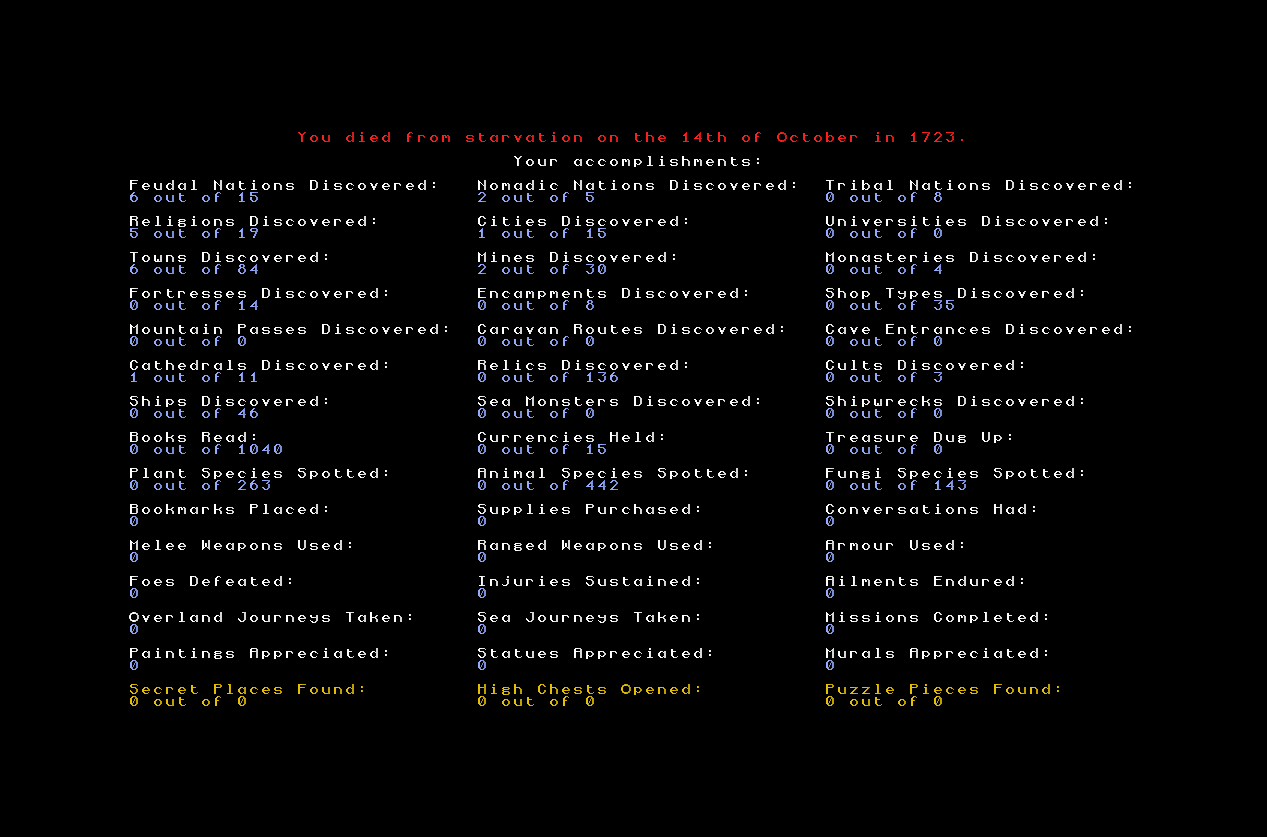
(Also, whew, 1040 books generated in a single world! Working on generating the content of those books, and making it highly meaningful and logical and filled with potential game clues, is going to be a lot of fun.)
Number items and weight
The weight of canteens, food ration bags, and equipment packs, now changes logically as you consume the stuff which is in them. Food ration bags and equipment packs both have a weight of “2” – for having 6/7/8/9/10 rations / pieces of equipment in them – and now go down to a weight of “1” when they have 1/2/3/4/5 inside them. The same is also true of canteens, with a base weight of “1” but going up by 1 for every two units of liquid inside them, up to a maximum of a weight of “6” for 10/9 units (and “5” for 8/7 units, and so on down). These update and change whenever you use them and as far as I can tell this works in all contexts now that it should be working in. So for example, here are your supplies when you start a new game, i.e. a canteen with ten units of water and four packs of food rations with ten rations each:
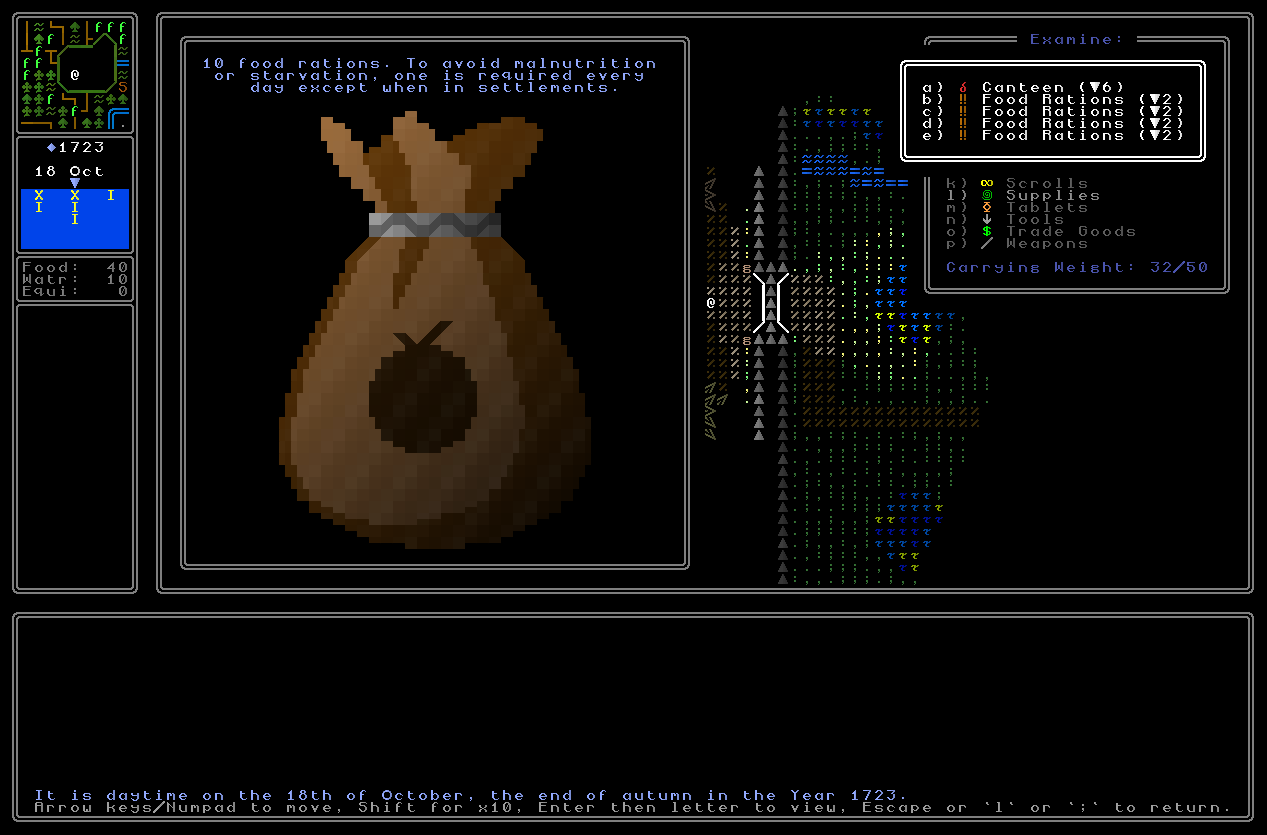
And then after some exploring over half of the rations in this food pack have been used up, and so the weight (and the player’s total held weight!) have both reduced by one:
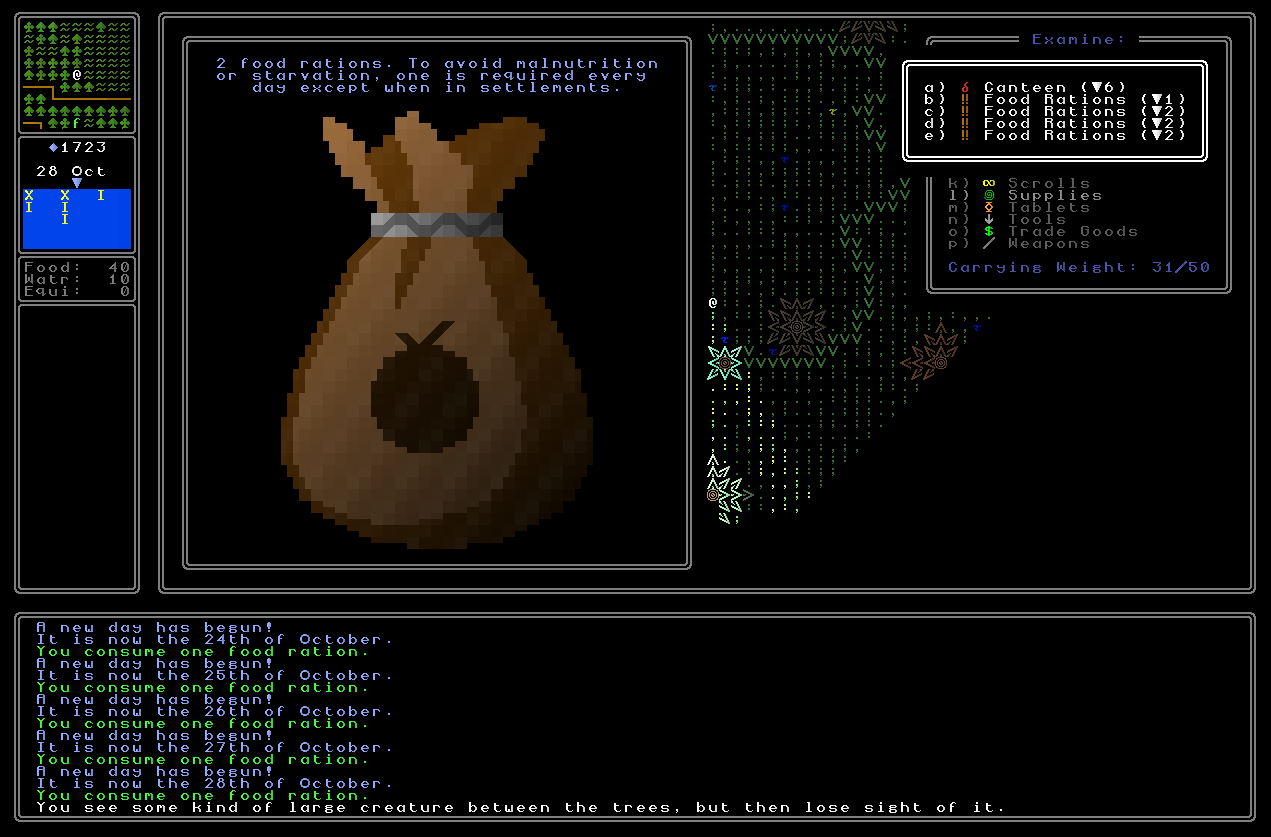
And then later after eventually finding our way to a desert and using up some of the canteen, it no longer contains 9 or 10 units or water (for a total of 6 weight, 5 per 2 units and 1 for the canteen itself) so now weight 5 instead (4 of which comes from the 7-8 units of water it holds and from 1 from the canteen). All of this also has the nice side effect that the more you explore on an expedition the more weight you’ll free up in your inventory to bring back what you find. This was a key mechanic in one of my favourite games from two years ago, The Curious Expedition, and I don’t mind admitting that I think it’ll work really very nicely here as well.
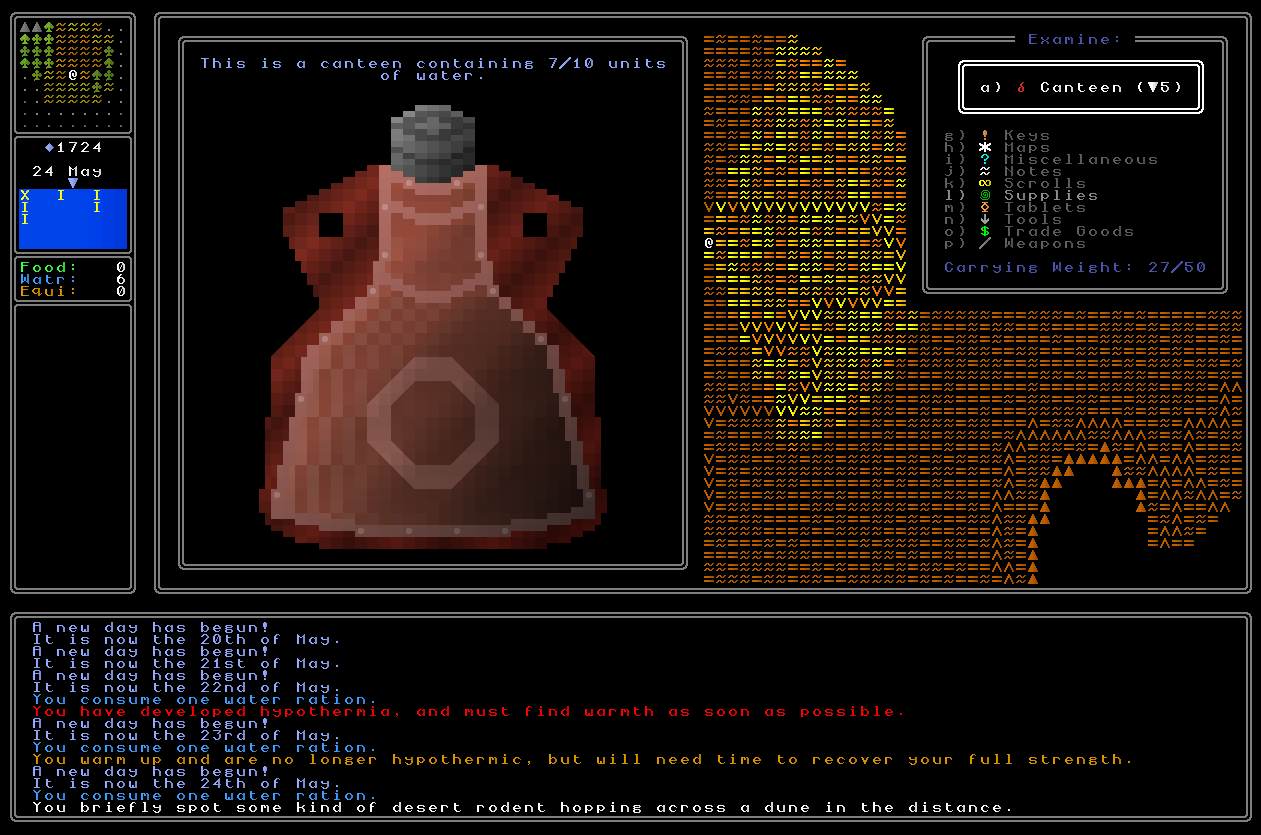
Religious issues
I also found a graphical issue with some religions in the “normal” archetype (i.e. not a “demonic”, “Lovecraftian”, “pantheon” or “Egyptian”-style religion – the “normal” archetype is generally use for around 75% of the religions in a generated world with a smaller number selecting one of the other types). This graphical issue was manifesting in two places, with the religious symbol on religious books sometimes appearing very strangely indeed (on the left hand side of this image) and the symbol on altars sometimes just deciding of its own free will not to be shaded at all, and consequently looking rather strange (on the right hand side).
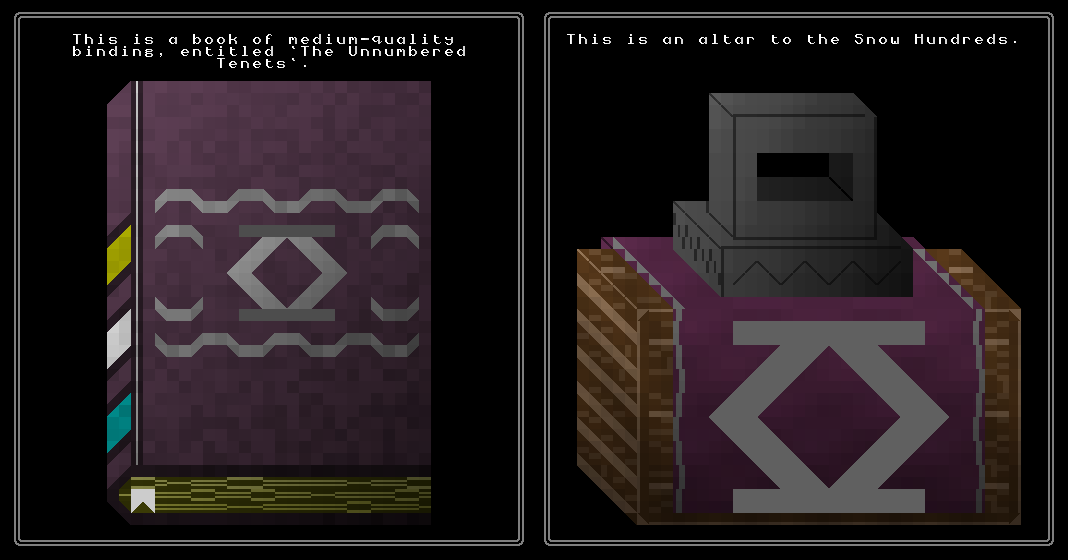
It took a little while since it has been a long time since I did anything with this particular graphics generator, but I was able to hunt down the issue and deal with it. Incredibly this was a hangover frmo the transition from Python 2 -> Python 3 years ago and was – I hope – the very last thing that I hadn’t previously noticed as being a little bit amiss as a result of making the shift. I believe these are all now fixed though, resulting in some much nicer looking religious altars and holy books:
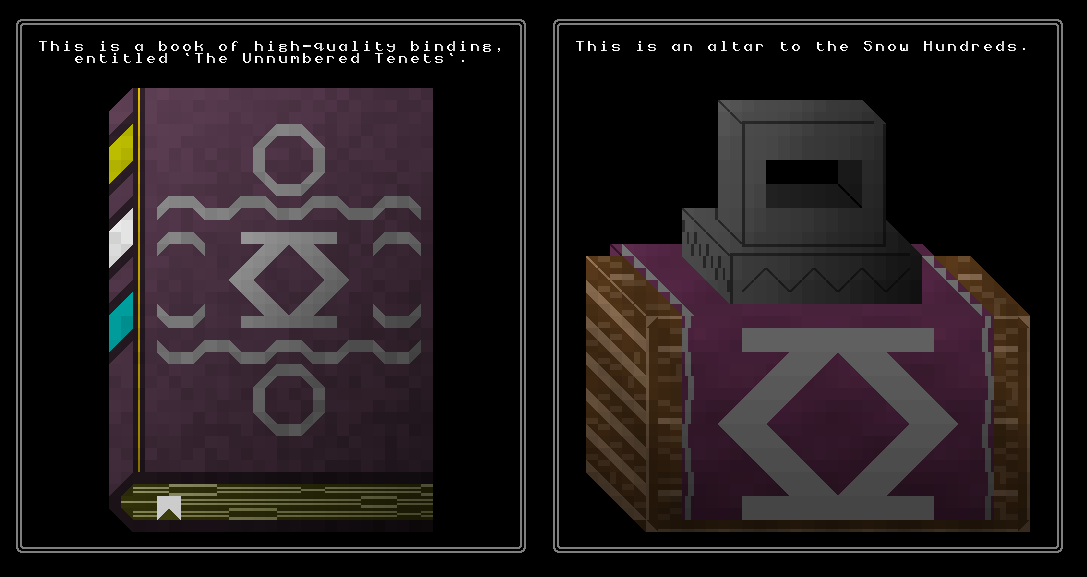
At the same time I also noticed another bug, which was that the colouring of the religious robes for the priests in some religious buildings is incorrect. It seems to always be correct when it’s for one of the special religious archetypes, but for the “generic” religion archetype the wrong colour of robe was definitely popping up from time to time. For instance, here’s a book, altar, and robe for the religious building I was testing the above thing in…
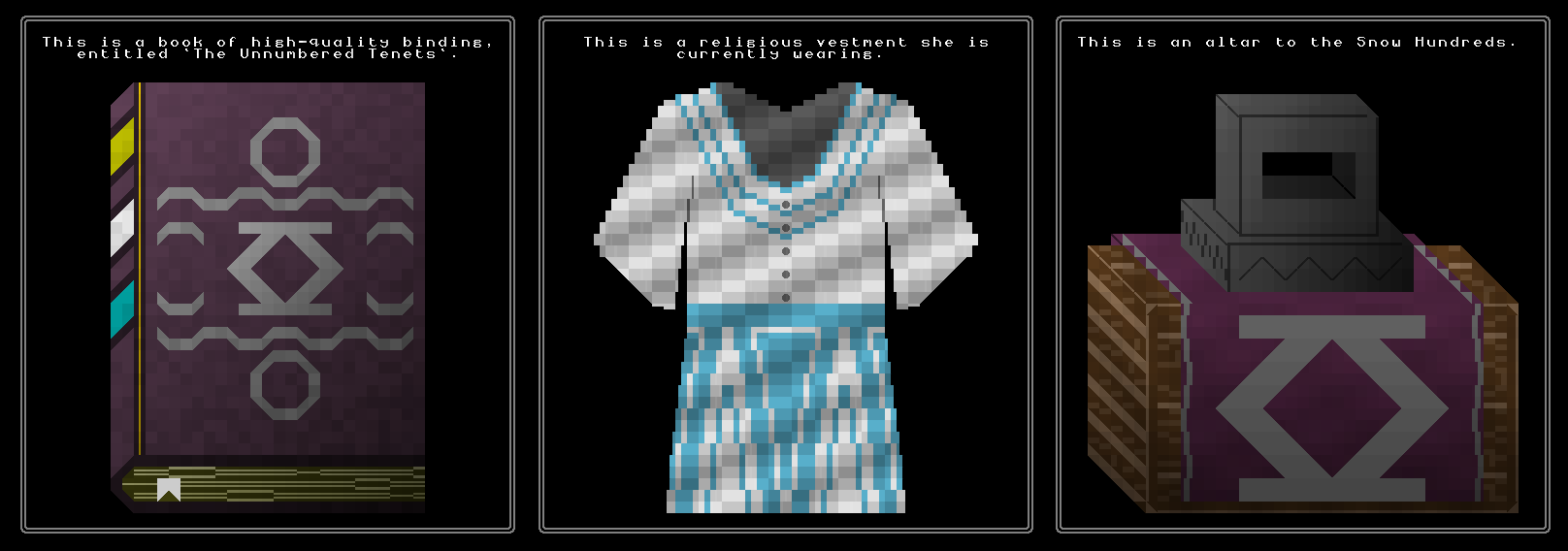
…and one can pretty clearly see that one of these does not match (and one can also see that one of the image qualities here is much lower than the others and came from a much earlier time of working on procedural image generation, and will need updating to come in line with the image quality I’m working with now, but that’s a task for another time). A quick bit of fiddling and work later, however, and this problem appears to be solved, with the game now correctly giving priests the right (if aesthetically mediocre) robe for the religion in question:
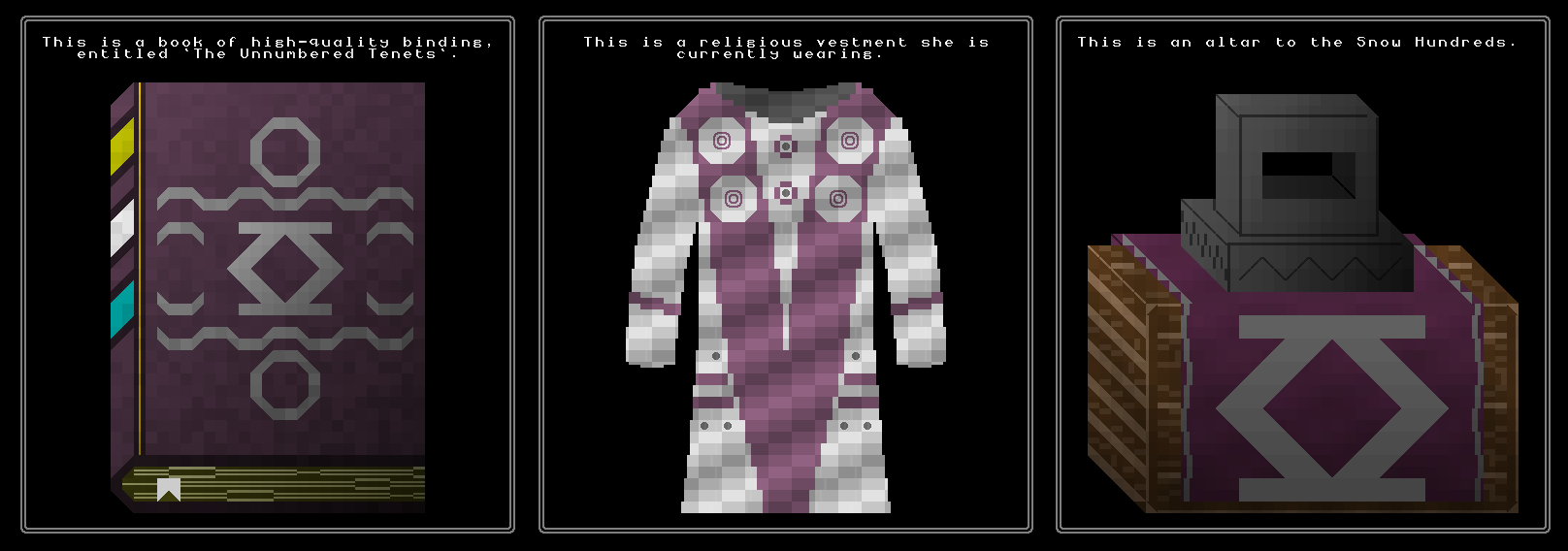
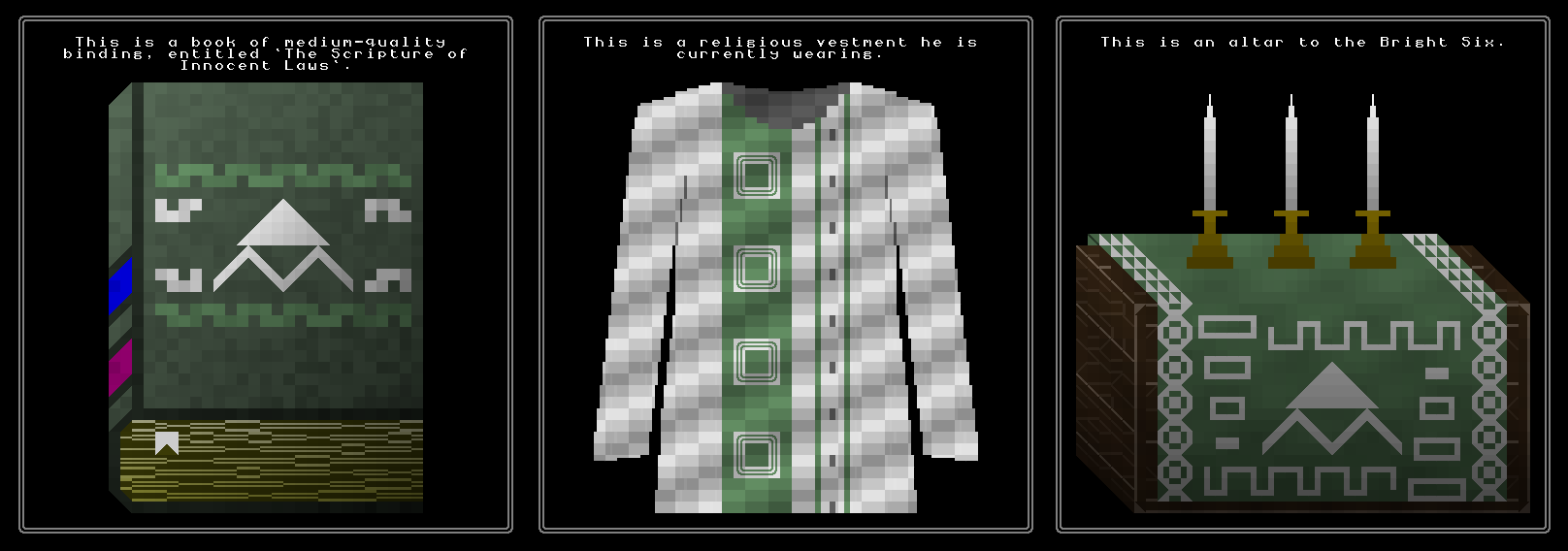
I also in this process noticed that holy books were sometimes not spawning in appropriate numbers in some religious buildings. This issue seemed to be focused on the tables that might spawn in the branching sections away from the core of a religious building, i.e. holy books might spawn on tables in the middle of a religious building, but seemed very disinclined to spawn on tables in the branches (which in the generation system are placed later on). Again it happily wasn’t too much work to hunt down the issue here and get it fixed:
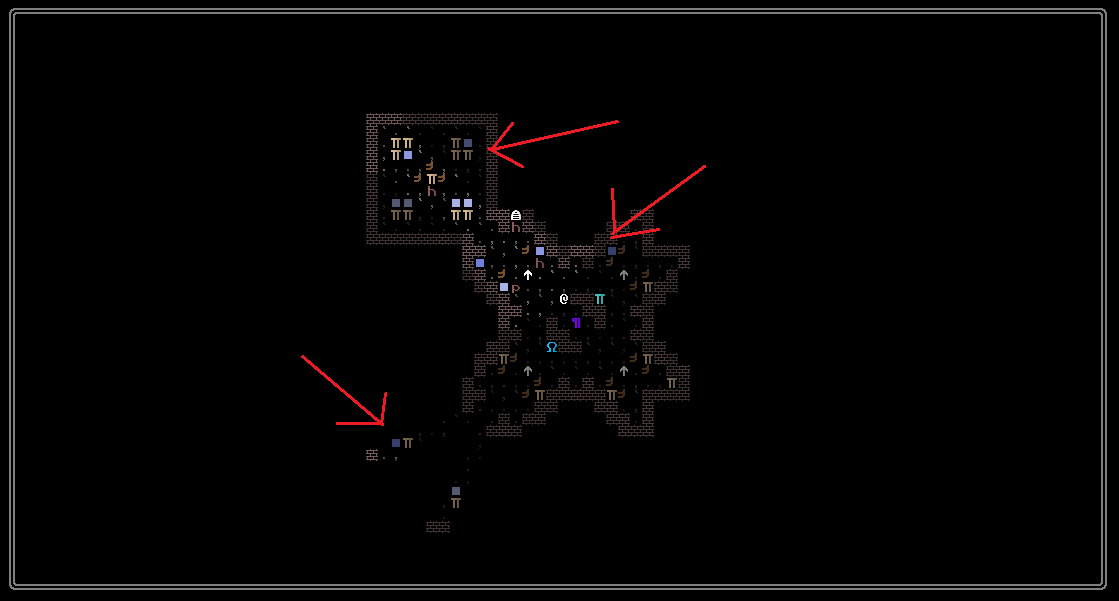
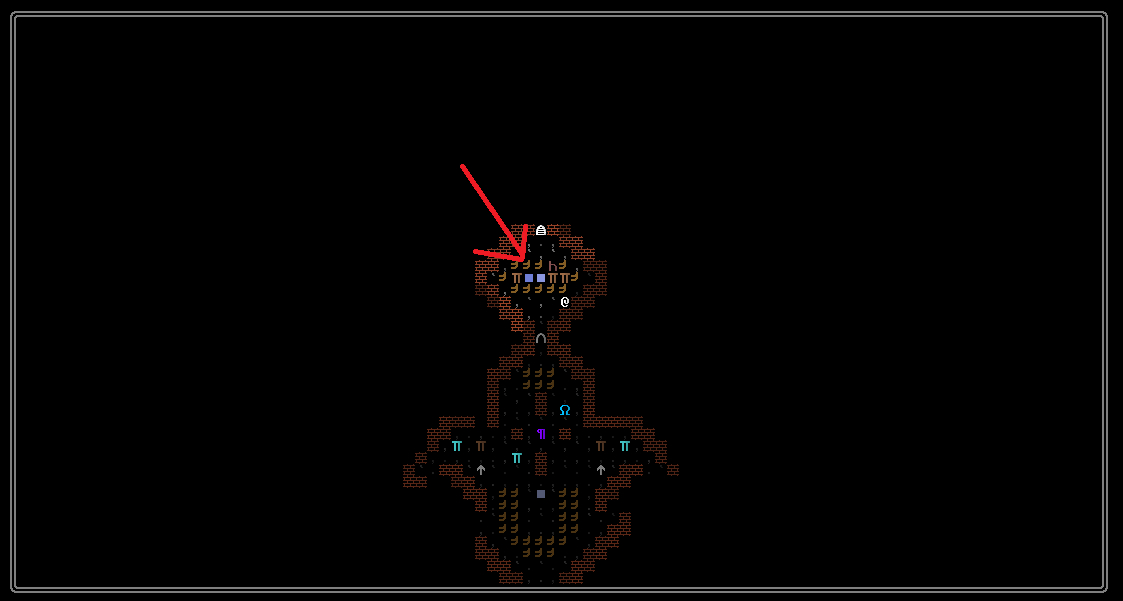
On foot
A number of the new features and mechanics were working fine when used how the player will normally be using them, but were causing some lingering issues when being used in other contexts. These particularly involved doing things on foot rather than with the travel menu, which is always an option and needs to be appropriately catered for. The main two issues were the time of day iterating correctly when you were on foot – specifically when the day changed from one day to the next after passing through midnight – and the game giving you the menu to decide what you wanted to do at a city gate after unloading the current area but before passing through, leading to a crash if you just decided to turn back around and various other bizarre (both programmatically and visually) outcomes if you chose some of the other options.
In the first case the game can now correctly move from one day to the next by simply the time ticking over midnight – instead of the normal thing of moving one day to the next when you move across a map grid into the next one along – and doesn’t cause any weirdness with the visuals, nor incorrectly saying rubbish about you being in a town when you are not, actually, inside any kind of settlement. As a result of working on this I have also decided on a model where food and the like are only consumed when moving map grid – this might seem just fractionally strange ordinarily, but I think will work well under gameplay conditions, i.e. preventing scenarios where from the player’s perspective you are randomly charged a food or a water supply while you’re just walking around a map grid talking to people or doing whatever you might be doing. In the second case the game now gives you the menu you get at a city gate when you move into the city gate but before unloading the area you are currently in, allowing you to potentially turn back around and do something else without the game misbehaving, and allowing you to also use the other options (exchange currency, buy supplies, etc) and then be able to immediately go back to moving around the map grid you are on without a crash, a need to reload, or any other blasted weirdness.
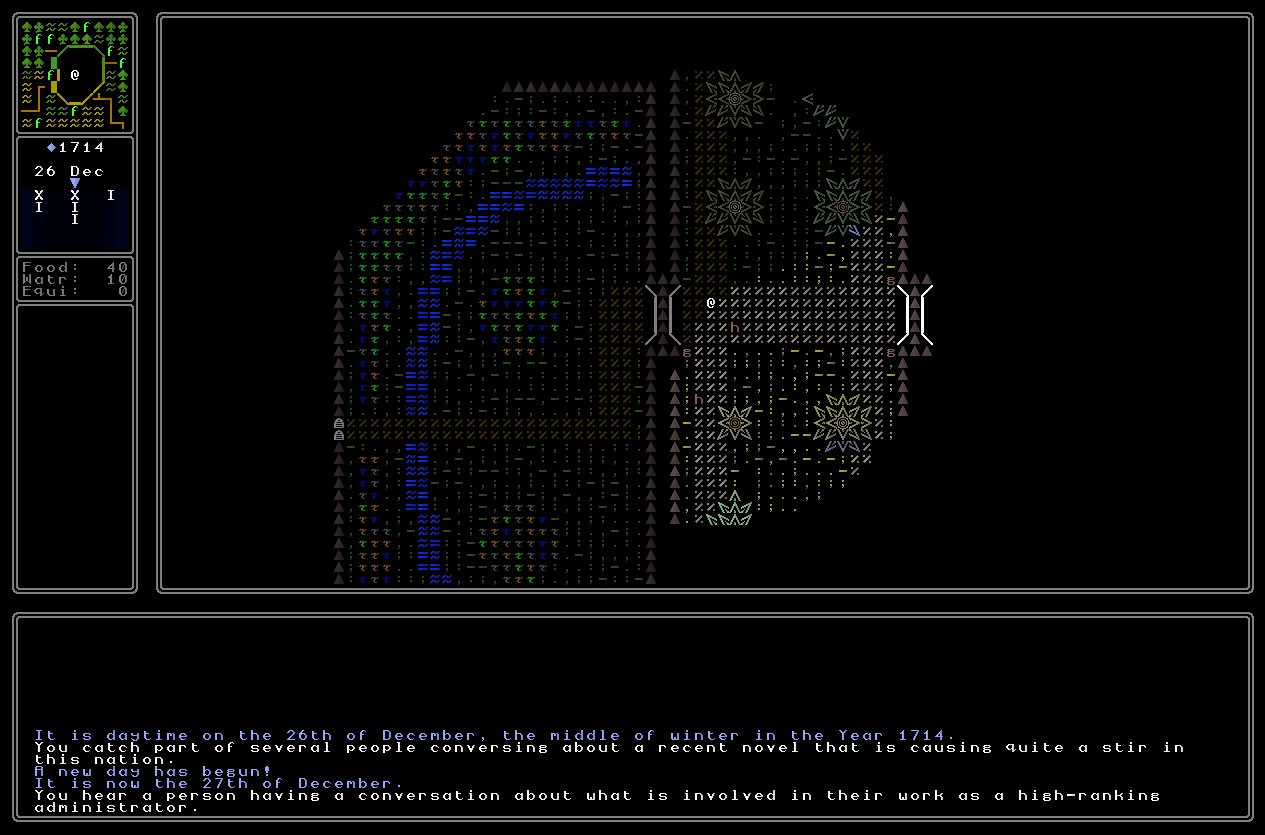
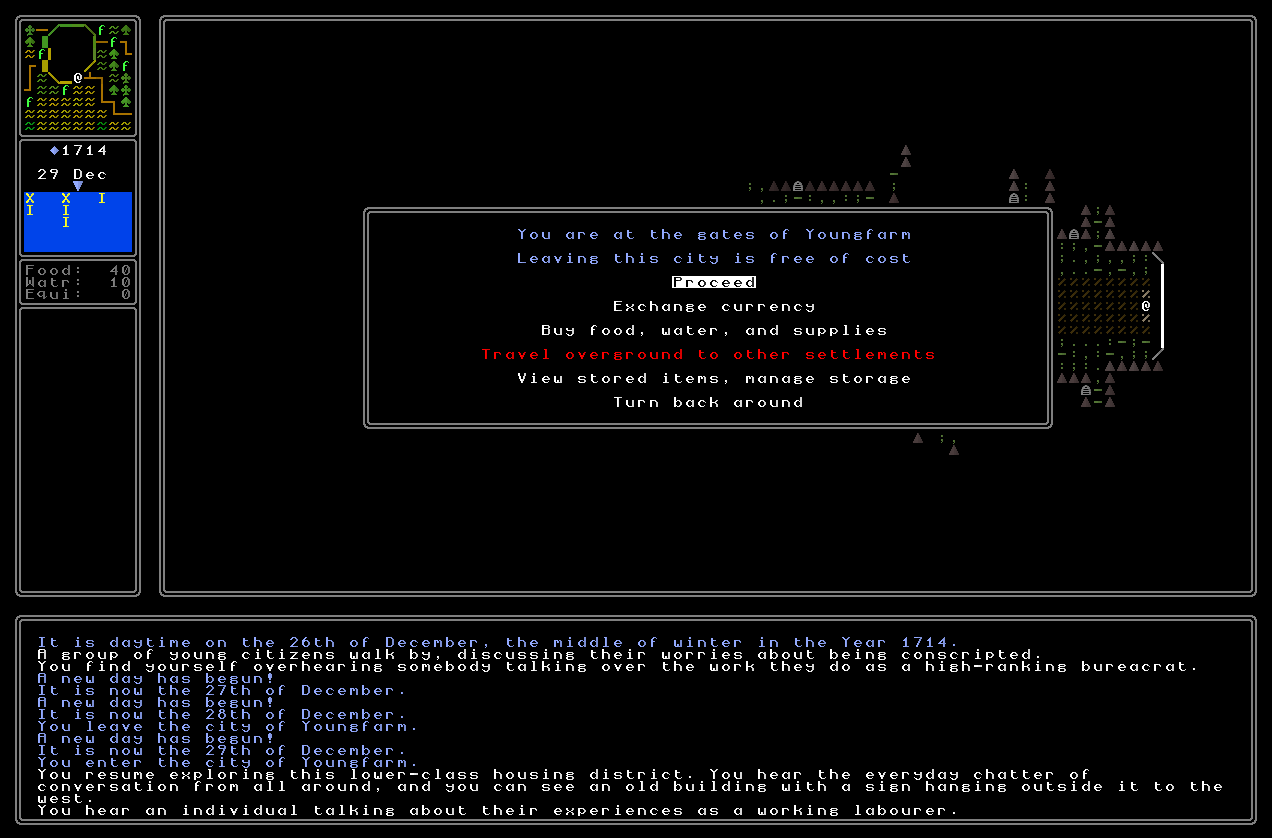
Fungus
The game presently generates large numbers of plants and animals – though only the plants at present actually appear in the game world with lovely new generated images in 0.10 – all of which are designed both to enhance and further the alive-ness of the game world, but also to serve as potential clues.
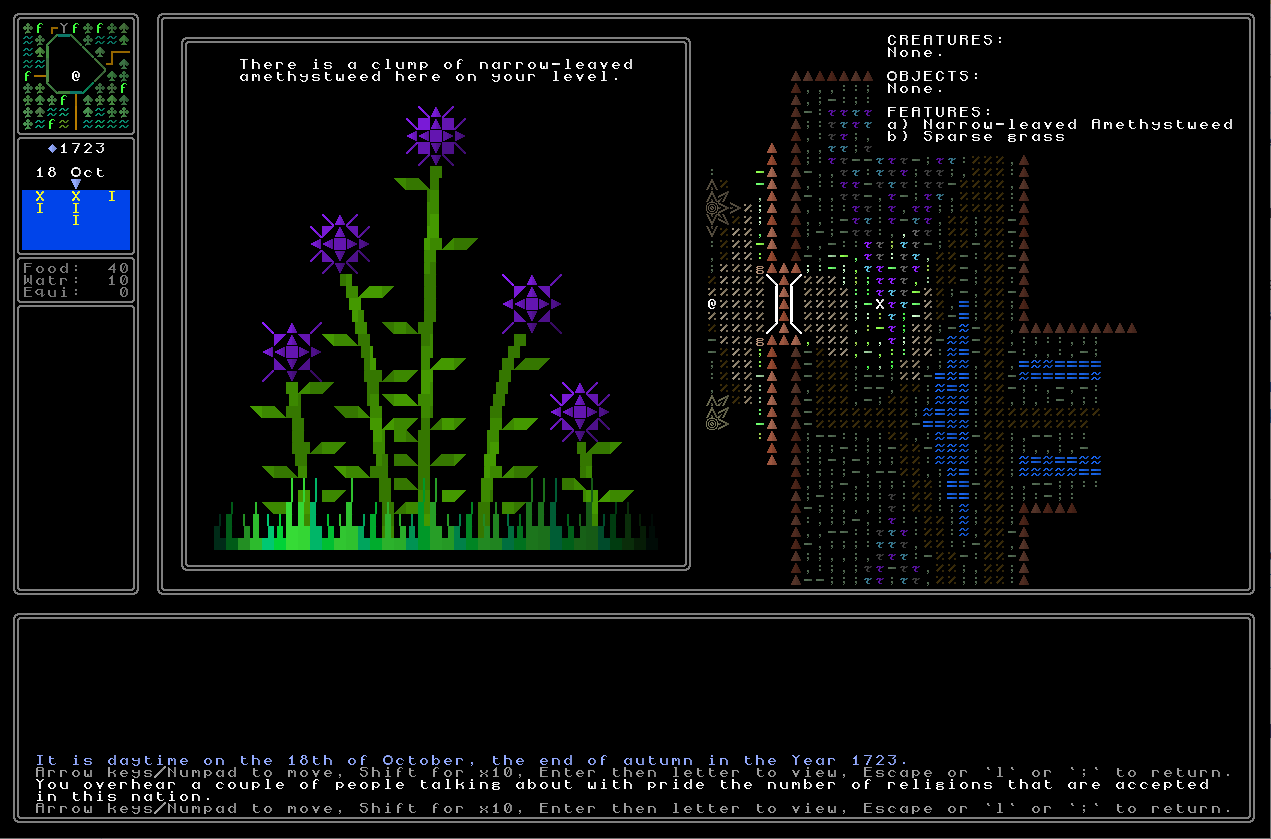
Maybe you learn a mansion with a garden full of plants with particular properties houses a great secret, and you need to research with herbalists and through books which plants possess that property, and hence which plants to look for in the gardens of local manors. Maybe you hear of a treasure buried in the area where the Two-Antlered Snow Deer performs its mating rituals; then you find a book about that animal and discover the exact location; and then you go there and try to find what’s buried. Although they might not appear for a little while, I’ve now also implemented a generator for fungi. I think these are mostly going to appear in cave / underground areas once those are implemented (though maybe also, far more rarely, above ground – or perhaps the more they appear above ground, the closer you are to a cave entrance?) but it was a really fun hour to design this generator and get these names implemented into the game’s tracking for future reference, future image generation, and future clue integration.
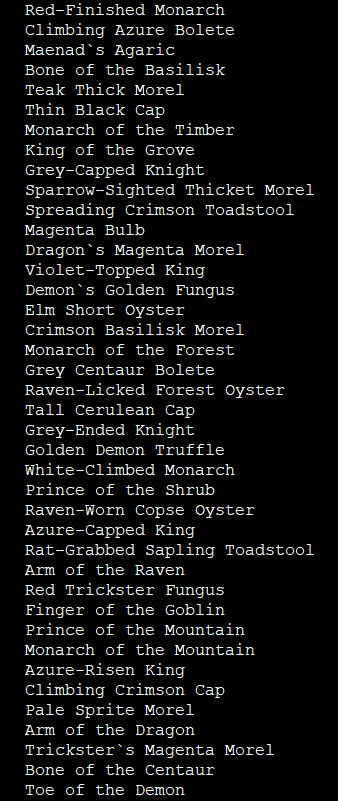
Bugs and the like
- General / walking-around messages in areas where the main thing is only in the centre of the map grid, such as monasteries and fortresses and towns (and later mines, universities, etc) no longer trigger if you’re at the edges of the map grid. This is a good change since it seemed a bit strange when you were talking through trees and the game said “Two people walk past you discussing [whatever]!”.
- Fixed, for what feels like the fifteenth time, the bug with priests sometimes perching themselves on top of altars like some kind of mad religious bird. I am now pretty certain priests will never stand on top of altars, and at most will stand next to them, regarding them with fervent awe.
- Entering the travel menu, moving into an exit from the city, and then choosing to turn back around rather than go through that exit, no longer results in a crash.
- Spawning a religious building, leaving and then coming back under a very specific set of circumstances, no longer causes the game to crash trying to figure out what the priest should be doing when you return.
- In anticipation of replacing reliquaries with the actual relics themselves in 0.10 (and because the reliquary as an item/feature no longer really works with the ideas I want to develop for religions), all reliquaries have now been replaced with offering tables in religious buildings, and will subsequently next year have relics spawning atop them.
- The text on the edge of the currency exchange screen will no longer sometimes get chopped off when dealing with currencies that have particularly long names.
- The starting year, month, and day of the game are now lightly randomised.
- Buying something or a number of somethings from the supplies menu now correctly and at the right time updates the sidebar showing your supplies of food, water, and equipment.
- Offering tables in churches now actually have different colours for when in vision, and outside of vision.
- Trying to place plants in a snowy biome can no longer sometimes lead to a crash; instead the game looks for plants that can spawn in that location, but if it finds none it selects a nearby area of tundra and uses the plants from that instead. Plants are also relatively sparse in snowy biomes compared to the others.
- You can now use the numpad 5 and the numpad enter to confirm things on even more menus which previously didn’t allow this (such as exchanging currencies).
- Indoor water now flickers and shimmers and changes colour each turn just like outdoor water does, and although one cannot currently find any kind of lava indoors, just in case this one day changes, the same would now work for indoor lava as well.
- Fixed a problem where monks would sometimes struggle to work out what religion they should belong to, and would instead opt for atheism, and crash the game.
What next?
Release!

Amazing stuff! So fun to see you’re posting updates, very exciting 😀
Thanks Uggo! It’s a joy to be able to get some regular coding done 🙂
Hey Mark, looonng time no post, glad to see you are well and working on URR again!
In real life Fungi/mushrooms spring up shortly after it rains and eat dead stuff. Maybe have something like that?
Hello Brad! Thank you my friend :). That’s actually a lovely idea; I’ve wanted to implement some kind of weather system for a while, too…
Thanks for putting so much time and energy into this project.
I love procedural storywriting and world generation, and sure, there’s some games providing that. But ¿Misteries? ¿Clues? ¿Hidden information and deductive processes? Not that many, and not at this scale. This, alone, makes URR really special.
Also, every screenshot looks so beautiful…
Thanks Alberto! I really appreciate the kind words :). You have nailed exactly what I’m going for – I don’t think any PCG game is really focused on mysteries and clues and hidden information (though a handful certainly touch on it) but that’s the real focus of what I’m going for. That and a nice aesthetic too, of course, so I appreciate the kind words on that front! I’m really looking forward to generating all the different kinds of religious relics in 0.11 – those should end up being really gorgeous in the end, I think.
Atheist monks ending the world, that’s funny.
Looking forward to the release!
Hahaha, thanks Joel! 🙂
These updates to the game look very interesting! I particularly like the possibilities presented of treasure/clue-hunting that requires the player to engage with the game and perform in-game research on generated content. I am excited to see how all of the content generation ties together with quests. Oh, and I would be totally fine seeing the occasional fanatical priest in the game standing on top of of an altar while crazily preaching to anyone within earshot. The imagery alone is hilarious.
Thanks crowbar! Yes, absolutely, that’s so core to what interests me and what I’m trying to build – that feeling of treasure-hunting and clue-hunting, and piecing things together… except procedurally generated of course. And ha, yes, re: the priests, I take your point, absolutely…!